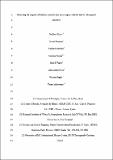Por favor, use este identificador para citar o enlazar a este item:
http://hdl.handle.net/10261/96354COMPARTIR / EXPORTAR:
 SHARE SHARE
 CORE
BASE CORE
BASE
|
|
| Visualizar otros formatos: MARC | Dublin Core | RDF | ORE | MODS | METS | DIDL | DATACITE | |

| Título: | Detecting the impacts of harbour construction on a seagrass habitat and its subsequent recovery |
Autor: | Roca, Guillem CSIC ORCID; Romero, J.; Columbu, Sabina CSIC; Farina, Simone CSIC ORCID; Pagès, Jordi F. CSIC ORCID; Gera, Alessandro CSIC; Inglis, G.; Alcoverro, Teresa CSIC ORCID | Palabras clave: | Indicator Disturbance P. oceanica Physiological indicators Time–response |
Fecha de publicación: | 2014 | Editor: | Elsevier | Citación: | Ecological Indicators 45 : 9-17 (2014) | Resumen: | Managing coastal development requires a set of tools to adequately detect ecosystem and water columndegradation, but it also demands tools to detect any post-disturbance improvement. Structural seagrassindicators (such as shoot density or cover) are often used to detect or assess disturbances, but while theymay be very sensitive to the impact itself, it is unclear if those indicators on their own can effectivelyreflect recovery at time scales relevant to managers. We used the construction of a harbour affecting anearby Posidonia oceanica seagrass community to test the ability of a set of indicators (structural andothers) to detect alterations and to evaluate their sensitivity to recovery of environmental quality afterharbour construction was complete and the disturbance ceased. We used a Beyond Before After ControlImpact (BBACI) design to evaluate effects on one impacted and three control meadows where we usedstructural, morphological, community and physiological indicators (26 in total) to asses disturbanceimpacts. Additionally, we measured some of the potential environmental factors that could be alteredduring and after the construction of the harbour and are critical to the survival of the seagrass meadow(light, sediment organic matter, sediment accrual).Harbour construction caused a clear increase in sediment organic matter and in sediment depositionrates, especially fine sand. Light availability was also reduced due to suspended sediments. Sediment andlight conditions returned to normal levels 5 and 15 months after the construction began. As expected,seagrass structural indicators responded unequivocally to these environmental changes, with clear reduc-tions in shoot density. Additionally, reduced light conditions quickly resulted in a decline in carbohydratecontent in affected meadows. Unexpectedly, we also recorded a significant increase in metal content inplant tissues. No response was detected in the physiological indicators related to eutrophication (e.g.N and P content in tissues) and in morphological (shoot biomass) and community (epiphyte biomass)indicators. More than three years after the completion of the harbour, structural indicators did not showany sign of recovery. In contrast, physiological indicators, mainly heavy metal and carbohydrates content,were much better in detecting the improvement of the environmental conditions over the fairly shortperiod of this study. These results indicate that while structural indicators are critical to evaluate theimmediate effect of disturbances and the recovery on impacted systems, specific physiological indicatorsmay be much better suited to determining the timing of environmental quality recovery. The design ofimpact and monitoring protocols in the wake of coastal developmental projects need to consider thedifferential effectiveness and time–response of measured indicators carefully. | Descripción: | 9 páginas, 6 figuras, 2 tablas. | Versión del editor: | http://dx.doi.org/10.1016/j.ecolind.2014.03.020 | URI: | http://hdl.handle.net/10261/96354 | DOI: | 10.1016/j.ecolind.2014.03.020 | ISSN: | 1470-160X | E-ISSN: | 1872-7034 |
| Aparece en las colecciones: | (CEAB) Artículos |
Ficheros en este ítem:
| Fichero | Descripción | Tamaño | Formato | |
|---|---|---|---|---|
| roca.pdf | 909,94 kB | Adobe PDF |  Visualizar/Abrir |
CORE Recommender
SCOPUSTM
Citations
20
checked on 11-abr-2024
WEB OF SCIENCETM
Citations
20
checked on 24-feb-2024
Page view(s)
482
checked on 19-abr-2024
Download(s)
344
checked on 19-abr-2024
Google ScholarTM
Check
Altmetric
Altmetric
NOTA: Los ítems de Digital.CSIC están protegidos por copyright, con todos los derechos reservados, a menos que se indique lo contrario.
